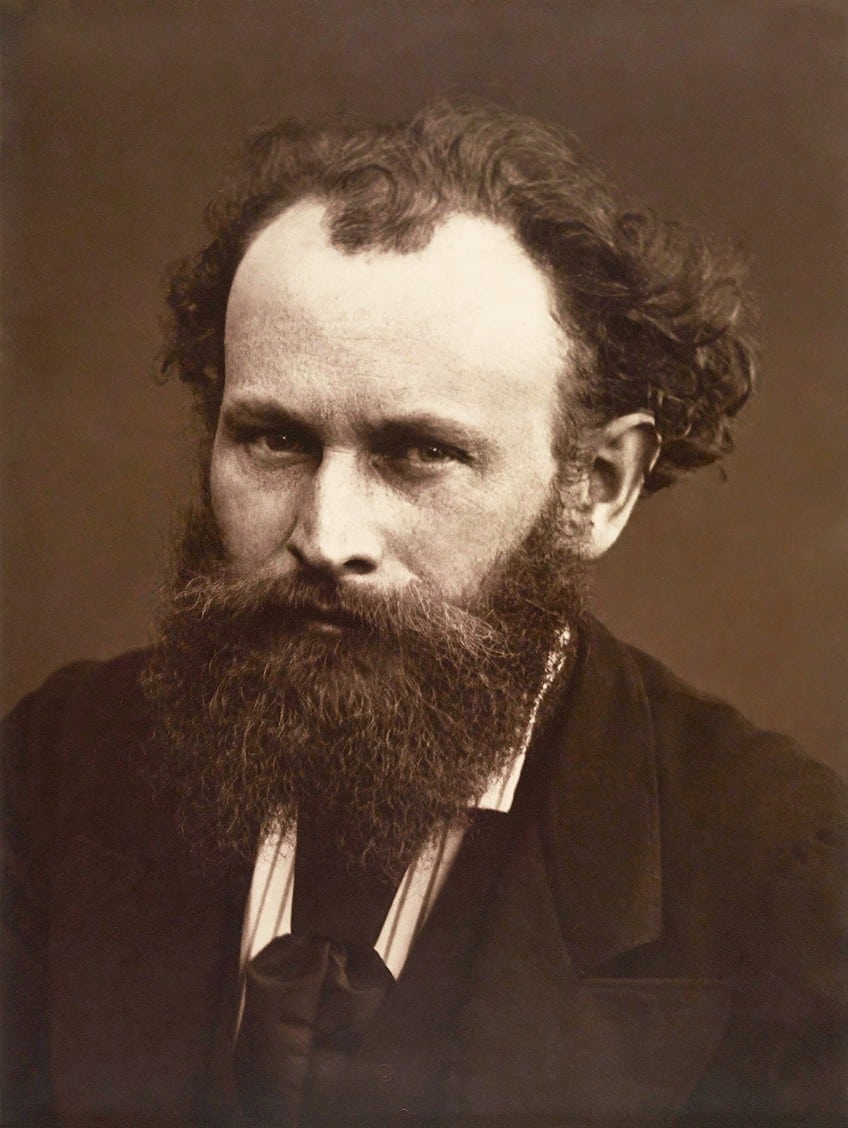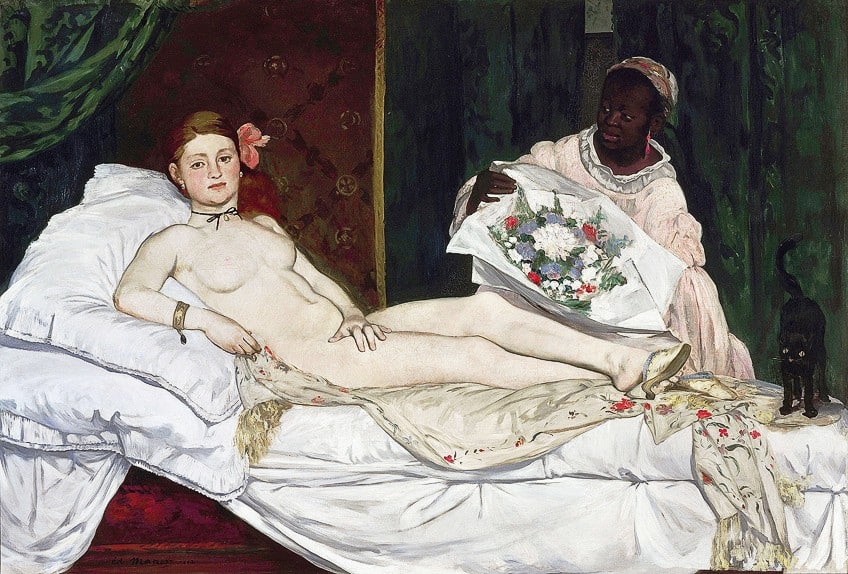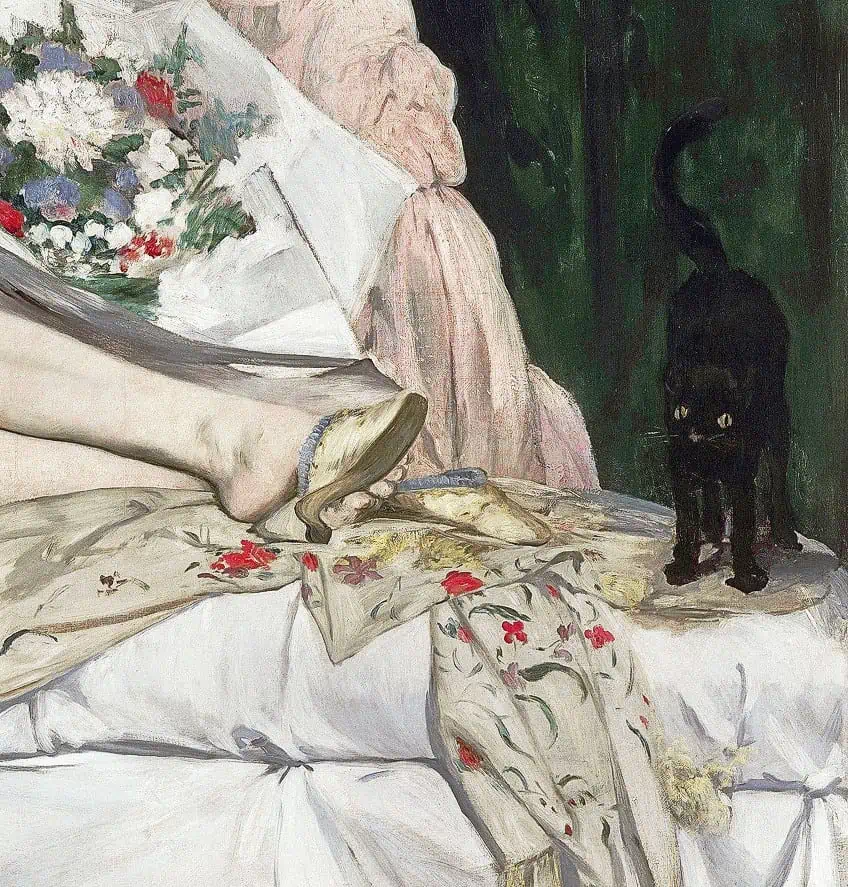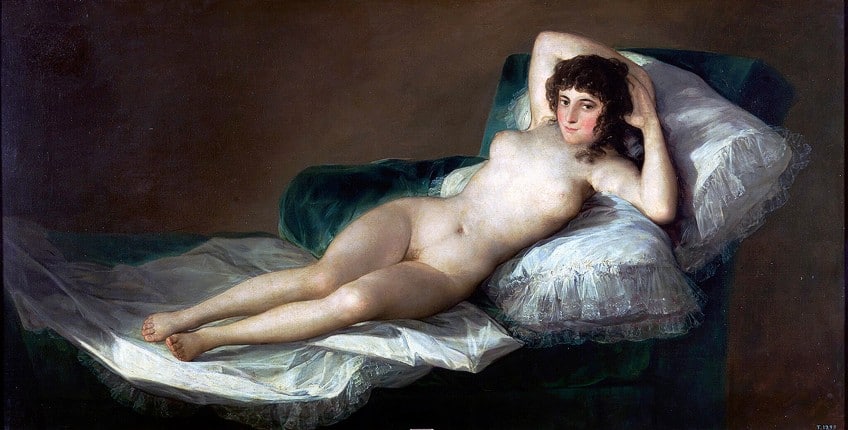“Olympia” by Édouard Manet – Explore the Controversial Work
Édouard Manet’s Olympia painting, the famous painting of a woman lying down on a bed, was first displayed at the Paris Salon in 1865. Many of the details of Olympia by Édouard Manet suggested that the woman in the painting was actually a prostitute, causing many to be shocked by her seemingly confrontational stare as she looks directly at the audience. But, what was the artist of Olympia trying to do by being so intentionally provocative? We will answer that question in the article below, as we take a deep dive into Manet’s Olympia analysis.
Understanding Olympia by Édouard Manet
| Artist Name | Édouard Manet (1832 – 1883) |
| Date Completed | 1865 |
| Medium | Oil on canvas |
| Dimensions (cm) | 130.5 x 190 |
| Location | Musée d’Orsay, Paris, France |
The Olympia painting’s title is typically attributed to Manet’s dear companion, the artist and art critic Zacharie Astruc because an extract from one of Astruc’s poems had been included in the catalog entry with the work of art when it was first shown at the Salon in 1865. Manet’s Olympia painting was purchased by the French government in 1890 as a result of a public subscription initiated by the artist Claude Monet.
Olympia by Édouard Manet is currently housed at the Musée d’Orsay in Paris, France.
A Brief Introduction to Édouard Manet
Édouard Manet has been widely regarded as a contemporary art pioneer and a vital contributor to the modernization of French painting between 1863 and 1883. His avant-garde art impacted Impressionist artists, who in turn shaped his own brushwork and color palette. Édouard Manet was an important 19th-century artist from France who played a key role in the shift from the Realism style to the Impressionism style.
Manet was born into a wealthy household and first studied law. His love of art, though, prompted him to give up his law studies and pursue art instead.

Manet’s works, particularly Olympia, had a tremendous impact on the history of art. Manet’s works deviated from the academic standards that controlled the art industry at the time. He shunned romanticized and refined portrayals in favor of a more honest and straightforward depiction of his subjects, which were typically derived from the contemporary life of the time.
He criticized and disrupted traditional narratives, allowing viewers to rethink and reevaluate the established canon of art.
Manet’s Olympia Analysis
It was not the fact that Olympia was portrayed as being completely naked that astonished viewers when they first saw the painting, but rather her direct gaze at the viewer that was regarded as almost confrontational, in addition to a multitude of objects that clearly identified her as being a prostitute. These objects included the orchard in her hair, the oriental rug on which she lay, and her jewelry, such as her pearl earrings and bracelet, all of which were typically regarded as symbols of sensuality and opulence.
The sensual atmosphere is further enhanced by her slipper, which has been cast off, and the contrast of her pale skin with the black ribbon which is tied around her neck.
Manet’s Olympia painting is believed to be based on the Venus of Urbino (1534) painting by Titian. While Venus’s left hand is curled and seems to try and tempt in Titian’s painting, Olympia’s left hand appears to obstruct, which has been understood as representative of her job as a working girl, allowing or limiting access to her body in exchange for money. Manet substituted Titian’s dog (a sign of faithfulness) with a black cat, an animal that symbolized nocturnal promiscuity. The cat’s excited posture was suggestive; cat is slang for a female’s genitalia in the French language.

Olympia dismisses the flowers handed to her by her maid, which were most likely a client’s gift. Some speculate that she is glancing toward the door as her client walks in uninvited and that we are viewing the scene from the angle of the client. This work of art’s style diverges from the academic canon, with broader, faster brushstrokes, studio lighting that largely eliminated midtones, shallow depth, and huge color surfaces. Unlike Alexandre Cabanel’s smoother idealized nude woman in La Naissance de Vénus (1863), Olympia seems more like a real woman whose nudity is accentuated by the harsh lighting.
In essence, Manet is purposefully undermining the norms of academic art and its archaic principles by refusing to portray her in an idealized manner, in fact, by making her as unattractive as possible (the harsh illumination and pale skin further reduce her desirability).
Manet believed that these outdated principles had no place in a progressive arts regime, in contemporary France. The size of the canvas is 130 x 190 cm, which is rather enormous. Because the majority of artwork of this scale featured mythical or historical events, the artwork’s size, among other reasons, took many by surprise. Finally, Olympia is rather thin by contemporary artistic standards. Thinness, according to Charles Baudelaire, was regarded in those times as being more indecent.

Victorine Meurent, the woman that served as the model for Olympia, would have been recognizable by observers of this work of art because she was a prominent figure in Parisian society. She began modeling at the age of 16 and was also an exceptional artist in her own right. Some of her works have even been displayed in the Salon Paris. Viewers were apparently shocked by this artwork since they were familiar with the model.
In those days, a well-known woman living in contemporary Paris was not allowed to represent a mythological or historical figure.
Critical Reaction to Olympia by Édouard Manet
Although one of Manet’s other works of art, The Luncheon on the Grass, prompted debate in 1863, his Olympia provoked much more outrage when it debuted at the Paris Salon in 1865. The piece was deemed to be too vulgar and immoral by the conservatives. “If the painting of Olympia by Manet was not destroyed, it was only due to the preventative measures taken by the organizers”, journalist Antonin Proust subsequently recounted. Both reviewers and the general public universally criticized the piece.
Even Émile Zola was compelled to ridicule the artwork’s formal aspects instead of appreciating the subject, saying, “You sought a nude, and you picked Olympia, the very first one that came along”.
He did, however, praise Manet’s truthfulness: “when our painters present Venuses, they fix nature, they deceive. Édouard Manet questioned why he should need to lie, why not reveal the truth; he presented us with Olympia, this female of our day whom you encounter on the streets”.
Criticisms of Olympia’s Maid
Despite being disregarded at first, the character of the maid in the work of art, modeled by a lady named Laure, has been a source of debate among modern researchers. In the updated 1990 edition of The Painting of Modern Life, T. J. Clark describes a friend’s surprise: “you have written extensively about the pale woman on the bed for around 50 pages or more, and barely addressed the black woman beside her”.
Manet’s Olympia painting was produced 15 years after the abolition of slavery in France, but prejudices about black people lingered among certain sectors of French society. The white prostitute in the image was characterized in some situations using racially inflammatory words.
References to Blackness thus permeated the representation of white Olympia, transforming her into the hideous animal that Blacks were often represented as in the 19th century. Several observers praised Manet for using white and black in his paintings as a substitute for the technique of chiaroscuro. “The black servant is not merely the dark counterpart to Olympia’s paleness”, says Charles Bernheimer, “but instead a representation of the dark, dangerous, deviant sexuality hiding just beneath Olympia’s hand”. At the very least, this is the dream that Manet’s maid figure may have sparked in the masculine audience of 1865”.

Several black feminists, such as Lorraine O’Grady, have claimed that Manet incorporated the maid not for artistic conventions but rather to establish a conceptual distinction between white and black, bad and good, dirty and clean, and in doing so “invariably redefines the Cartesian perspectival reasoning which enables being white to continue functioning as the only topic of consideration”, according to Timothy Paul. When juxtaposed with a complexion that is paler, the Black female model represents all of the West’s racial prejudices.
Olympia shares characteristics with Realism in terms of style, which attempted to represent subjects accurately and honestly, usually tackling political and social issues. However, Manet’s style in this work of art includes aspects afterward identified with Impressionism.
His free brushwork, dramatic composition, and inventive use of light and color anticipated the aesthetic ideals that Impressionist artists would adopt in the decades that followed. While this artwork received severe condemnation and public outrage at first, it also drew attention and acclaim from younger artists and critics who acknowledged its innovative traits. The painting subsequently became a crucial symbol of modern art, influencing succeeding creative movements such as Impressionism and the larger modernist developments of the latter part of the 19th and early 20th centuries.
The Confrontational Gaze of Manet’s Olympia
Lorraine O’Grady claims that “Olympia’s servant, as with all other peripheral Negroes”, is a robot designed to blend into the backdrop. While Olympia’s confrontational stare is often mentioned as the peak of resistance against patriarchy, Olympia’s servant’s oppositional gaze is neglected; she fades into the background, with little to no emphasis paid to the vital function of her existence.
According to Freudian theory, we’re aware that she embodies Jezebel and Mammy, and she is not regarded as a real person, instead, she is excluded from sexual difference.

Olympia is gazing directly at the observer, but her servant is also looking back. Catherine West states in her article that by adopting an oppositional gaze, we may recognize, analyze, reject, and alter these and other oppressive representations of Black women.
Incident at the Musée d’Orsay in Paris
Deborah De Robertis is a Luxembourgish performance artist recognized for her outspoken and provocative performances. Her January 2016 performance at the Musée d’Orsay in Paris drew widespread notice and provoked a debate about art, censorship, and the limits of artistic freedom. During her performance, De Robertis sat on the floor in front of Manet’s Olympia painting imitating the painting’s subject – a nude woman reclining.
De Robertis was completely naked, and she wanted to emulate Olympia’s confrontational look and strong presence. Her objective was to engage people in a discussion of Manet’s artwork and investigate the convention of female nude in art history, but her performance generated a lot of attention.
Guests and security reacted rather negatively to the performance, and De Robertis was detained by French police and accused of indecent exposure. This incident underscored the present arguments over censorship, nudity, and the significance of performance art in public areas. Certain critics maintained that De Robertis’ performance was a respectable form of creative expression, while others thought it went too far in the context of public space.
The Symbolism of Olympia by Édouard Manet
Although we briefly touched on some of the painting’s symbolism in Manet’s Olympia analysis, we will now explore the meanings behind the various objects and subjects in greater detail. Olympia, the painting’s central character, is a courtesan, which was known as a high-class prostitute. She is portrayed with a very direct stare that almost seems to challenge the viewer.
Olympia’s nude body and aggressive posture represent her sense of control and power within her chosen profession, challenging the traditional concepts of passivity that are usually associated with nude females in art.
A black servant in the background presents Olympia with a bunch of flowers. This illustration depicts the race-related and social dynamics of the period. The presence of a black maid serves to emphasize the contrast between Olympia’s position of authority and the ethnic and social inequalities that prevailed in 19th-century French society. Olympia’s hair is adorned with an orchid, which represents sensuality as well as exoticism. During the 19th century, orchids were regularly associated with sensuality and lust, and by putting them in this painting, Manet accentuates Olympia’s appeal and sexuality.

Olympia is adorned with a bracelet and pearl necklace, both of which are signs of luxury and affluence. These accouterments imply that Olympia’s services as a prostitute are in high demand, emphasizing the concept of power and commodification. Not only does she wear objects of desire, but she is essentially one too, an object that can be attained at a price.
A slipper can be seen lying on the floor in the foreground. This dropped slipper represents intimacy and implies that Olympia was recently visited by a visitor, maybe a client. It indicates an interrupted moment of intimacy, illustrating her job as a courtesan even more.
Olympia’s reclining position on the bed further represents her sensuality and sexuality. It’s a place associated with physical contact, which reinforces the narrative of Olympia’s occupation and how she serves as a sexual object. Olympia’s bed is occupied by a black cat. Cats have always been connected with sensuality and autonomy, and it represents both Olympia’s freedom as a prostitute and her relationship to the domain of sexuality and passion in this context.
Comparison to Similar Works of Art
We already mentioned that Manet’s Olympia painting shares many characteristics with Venus of Urbino (1538) by Titian. It, too, features a naked woman reclining on a bed, with maids in the background and a pet on the bed. Yet, this time it is a far more sensual animal, a black cat. However, if we go back a few decades further, we can see the same subject matter and pose in Sleeping Venus (1510) by Giorgione.
Unlike Manet’s Olympia painting, which depicts a contemporary scenario with a prostitute, Giorgione’s work portrays a mythical Venus, the goddess of love, resting in a pastoral setting.
This image has a peaceful and ethereal feel about it. Manet’s depiction of Olympia is candid, direct, and uncompromising. Her nakedness is presented unabashedly, breaking cultural standards and idealized beauty traditions. Olympia’s stare draws the observer in and asserts her authority and agency. Venus is glorified and seductive in Giorgione’s image. Her figure is delicately depicted, exuding beauty and harmony. The artwork underlines the goddess’ ageless and divine character.

Manet’s style in Olympia combines Realism with early Impressionism. The brushwork is powerful and free, and the application of light and color is unique. The painting defies academic standards and anticipates modernist advances. With its precise attention to detail, flowing brushwork, and lifelike representation of shapes, Giorgione’s artwork is typical of the High Renaissance style. The subtle shifts between sunlight and darkness provide dimension and mood.
Another artwork that most likely influenced Manet’s Olympia was an artwork by Goya titled Maja Desnuda (c. 1797 – 1800).

Maja Desnuda by Goya depicts a reclining female nude in a more traditional and idealized style. The figure is sensual and gently portrayed, evoking the typical portrayal of female appeal. Her relaxed posture and intimate gaze engage the audience on a human level. This could be considered a prelude to the engagement between viewer and subject seen in the Olympia painting.
The Impact and Legacy of Olympia by Édouard Manet
The Olympia painting defied the conventional artistic traditions of the time. Manet abandoned romanticized depictions of feminine nudity in favor of a far more realistic and confronting image. The artwork notoriously sparked much public outrage and debate because it defied established ideals of morality, beauty, and gender roles. This famous painting of a woman lying down is sometimes viewed as a forerunner of contemporary art movements, notably Impressionism.
Manet’s Olympia painting experimented with historical artworks and reworked them for a modern audience. Manet was inspired by Titian’s Venus of Urbino and other older masterpieces, but he changed the subject matter and rejected the traditional narratives.
This recontextualization and reinterpretation of art history became an important part of the modern art movements that followed in the decades to come. It provoked intense arguments about the purpose of art, how sexuality is conveyed, and the power relations between the subject, the artist, and the audience. It raised questions on societal standards, gender roles, and the confines of freedom of expression.

It drew attention to art’s ability to confront and provoke, leading to a broader understanding of the cultural and social aspects of artistic representation. Manet’s Olympia also subsequently served as an influence on many other painters. Its influence may be observed in the paintings of Impressionist and Post-Impressionist painters such as Pierre-Auguste Renoir, Edgar Degas, and Paul Cézanne.
Manet’s Olympia is a famous painting of a woman lying down on a bed, donning nothing except a black ribbon, a gold bracelet, a pearl necklace, and a flower in her hair, all of which are regarded as representations of luxury and sensuality. A black cat sits at the foot of the bed, and a black servant is depicted offering her a bunch of flowers. Olympia was inspired by one of Manet’s favorite models, Victorine Meurent. The piece was sent to the 1865 Salon and, despite its alarming subject matter, was selected for admission. In any case, the artwork was put up for display and, inevitably, created considerable controversy. Over the decades that passed, it grew to be admired and appreciated for its shift away from the academic standards of the day.
Take a look at our Olympia painting webstory here!
Frequently Asked Questions
What Was the Artist of Olympia Trying to Do?
Manet was trying to depict an old subject matter in a modern context for his day and age. The Olympia painting by Manet helped redefine the creative norms of the time. It questioned the old art establishment’s dominance and opened the path for a more accessible and varied art world. The painting inspired artists to adopt new subject matter, innovate with techniques, and use their work to question traditional norms.
What Style Is Manet’s Olympia Painting?
This artwork marks a shift from the idealized styles of the time to a more realistic portrayal of the subject matter and, therefore, is part of the Realism movement. However, its influence would be felt far outside of just Realism. The Impressionists and Post-Impressionists, for example, were also influenced by this period of Manet’s oeuvre.
Jordan Anthony is a Cape Town-based film photographer, curator, and arts writer. She holds a Bachelor of Art in Fine Arts from the University of the Witwatersrand, Johannesburg, where she explored themes like healing, identity, dreams, and intuitive creation in her Contemporary art practice. Jordan has collaborated with various local art institutions, including the KZNSA Gallery in Durban, the Turbine Art Fair, and the Wits Art Museum. Her photography focuses on abstract color manipulations, portraiture, candid shots, and urban landscapes. She’s intrigued by philosophy, memory, and esotericism, drawing inspiration from Surrealism, Fluxus, and ancient civilizations, as well as childhood influences and found objects. Jordan is working for artfilemagazine since 2022 and writes blog posts about art history and photography.
Learn more about Jordan Anthony and about us.
Cite this Article
Jordan, Anthony, ““Olympia” by Édouard Manet – Explore the Controversial Work.” artfilemagazine – Your Online Art Source. October 20, 2023. URL: https://artfilemagazine.com/olympia-by-edouard-manet/
Anthony, J. (2023, 20 October). “Olympia” by Édouard Manet – Explore the Controversial Work. artfilemagazine – Your Online Art Source. https://artfilemagazine.com/olympia-by-edouard-manet/
Anthony, Jordan. ““Olympia” by Édouard Manet – Explore the Controversial Work.” artfilemagazine – Your Online Art Source, October 20, 2023. https://artfilemagazine.com/olympia-by-edouard-manet/.



